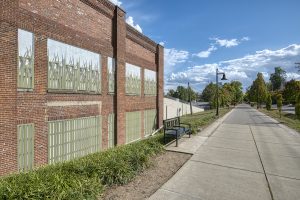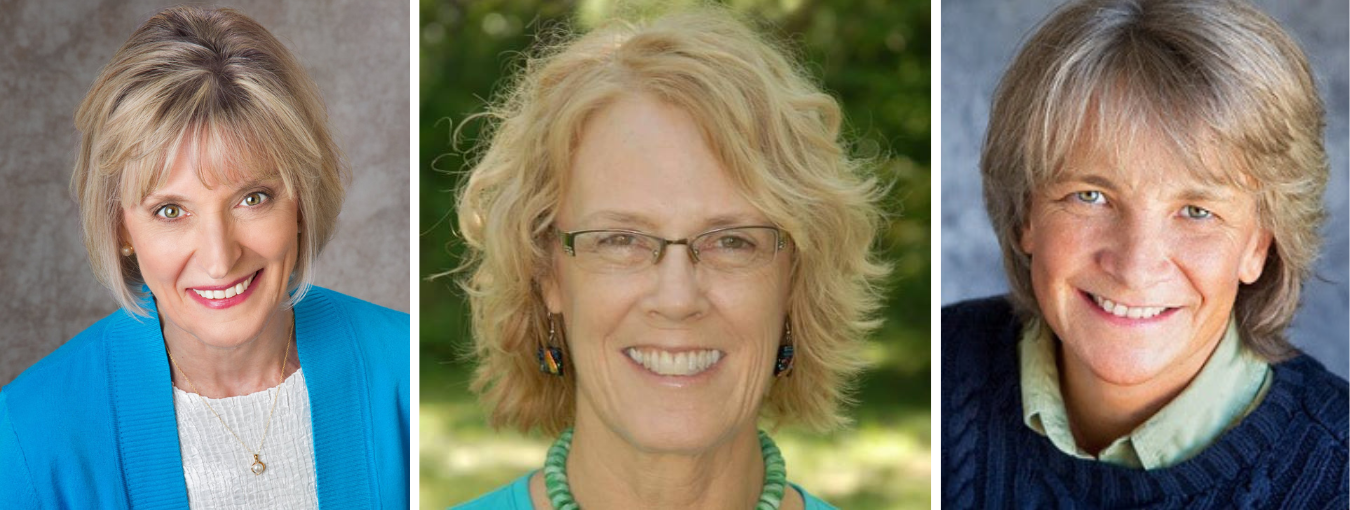For a time, it looked like the long-discussed expansion of the Monroe Convention Center was about to come to pass. Bloomington and Monroe County officials were talking about how to make it happen. They didn’t always agree, but they were talking. Hopes for progress were high.
Then the COVID-19 pandemic hit, and everything shut down: tourism, travel, and talk of expanding the center.
Now business leaders and some local government officials want to reboot the process, but they may face an uphill fight. Key decision makers in county government aren’t convinced that now is the time to expand the convention center. Or even that expanding is a good idea.
“I just feel we’re in such a time of flux and uncertainty, it doesn’t make sense to move forward with a huge project without knowing what’s coming,” says Julie Thomas, president of the Monroe County board of commissioners.

The convention center, which is owned by Monroe County, has a convenient downtown location along the B-Line Trail. People who want to expand the center may have an uphill fight. | Photo by Kendall Reeves
The Monroe Convention Center opened in 1991 in a former car dealership at 302 S. College Ave. Almost from the start, local tourism officials argued it needed to be larger. A 2003 Herald-Times column lamented that the center was “considered too small to attract even medium-sized conventions.”
It took years of lobbying, but finally local leaders got the Indiana General Assembly to authorize a 1 percent food and beverage tax to fund the convention center expansion or “related tourism or economic development projects.” That was in 2009. Then it took until December 2017 for the Monroe County Council to vote, 4-3, to impose the tax, despite vocal opposition.
“That was the hard part, the big, heavy lift,” says Eric Spoonmore, president and CEO of the Greater Bloomington Chamber of Commerce. “But there’s been no progress since.”
For two years, as restaurants and bars collected the tax, city and county officials went back and forth on how to expand the convention center. Who or what should manage the expansion? Should the center grow to the north, across 3rd Street, on city land? Or to the east, across College Avenue, on county property? Should all public land in the area be made of available, or just what’s immediately needed?
At one point, county officials were outraged that city officials had met privately with a prospective developer for a convention center hotel. Then-editor at the Herald-Times, Bob Zaltsberg, wrote that the process looked “less like two partners working cooperatively than like two foes watching each other like the U.S. and the USSR” during the Cold War.
Each side has a major stake in the project. The city, because it receives most of the food and beverage tax revenue, will contribute 90 percent of the funding. The county owns the convention center site. The project can’t advance unless the executive authority of each — the mayor for the city and the commissioners for the county — can agree.
“The county owns the asset; the city controls the money. Right away, that’s a challenge,” says Mike McAfee, executive director of Visit Bloomington, the nonprofit destination-marketing organization for the county and city and a leading promoter of expanding the convention center.
By late 2019, there seemed to be progress. The city appeared to agree to a proposal by the county commissioners to establish a capital improvement board to run the project. Each side would get three appointments to the board, and the seventh would be a joint pick. The sides still quibbled over details, but nothing seemed insurmountable. But with the pandemic, everyone hit the pause button.
Since then, both the county and city have tapped funds collected from the food-and-beverage tax to support local businesses in the hospitality sector, which had lost 2,000 jobs to the pandemic. The convention center expansion is still on hold.
‘Undersized when compared to other Indiana venues’
Monroe County is a popular destination for visitors, thanks to Indiana University, the lively Bloomington downtown, and nearby Monroe Lake, state parks, and forests. Surveys of Hoosier event planners find it’s the state’s second most-appealing locale for meetings after Indianapolis.
The 31,000-square-foot convention center hosts hundreds of events per year. A majority are local or have a “local context,” including proms, weddings, graduation celebrations, fundraisers, and community gatherings. Bloomington hotels, restaurants, and shops are busy on weekends but less so during the week. Officials say a convention center expansion could change that.
“A group that comes for Tuesday, Wednesday, and Thursday in February, a couple hundred people, using that space and going out at night — that’s what we’re after,” McAfee says.

David Smiley is a senior lecturer in the IU School of Public Health and a former recreation planner. | Courtesy photo
A 2012 market study by the consulting firm HVS found the center is “undersized when compared to other Indiana venues and national comparable venues.” David Smiley, a senior lecturer in the IU School of Public Health and a former recreation planner, visited the center when he moved to Bloomington ten years ago. “My first thought was, yeah, this is way too small,” he says.
Relying on the HVS market study, local officials developed a general plan to add 60,000 square feet, including a large exhibit hall and meeting rooms, at an estimated cost of $44 million. A private developer would be brought in to build an adjacent partner hotel.
Opinions are mixed on conventions as economic development. Well before the pandemic, a Brookings Institution report predicted declining interest in large, in-person meetings. Critics have long decried an “arms race” spurred by a “convention industrial complex” to lure bigger meetings. But the HVS market study said — a decade ago — that expanding the Monroe Convention Center would generate $18.3 million in annual economic benefits and support 260 full-time equivalent jobs.
“The direct money that comes in from a convention gets multiplied ten or more times,” Smiley says. As visitors spend on hotels, food, gas, and more, “all of that money is being brought into the economy.”
While Monroe County’s project stalls, other Indiana communities are cashing in, says Smiley, who formerly chaired the Visit Bloomington board. Paradoxically, the pandemic spurred communities to build new convention centers and expand old ones to compete in a tight market. Terre Haute, for example, drew statewide attention when it opened a $35 million downtown center in April, with capacity that surpasses Monroe County’s. Local officials say Terre Haute has been winning conventions that might otherwise come to Bloomington.
The potential for more business spending is why the Greater Bloomington Chamber of Commerce has made convention center expansion one of its top priorities.

Eric Spoonmore, president and CEO of the Greater Bloomington Chamber of Commerce. | Courtesy photo
“We absolutely view that as an economic development driver for the community,” says Spoonmore, the chamber president and a former county council member. “In terms of bringing people into Bloomington, into Monroe County, where they’re going to be spending money, there’s a huge ripple effect.”
Bloomington Mayor John Hamilton is also cheerleading the project. He says it will boost the region’s economy and make the city’s downtown more vital. He envisions an expanded convention center and new hotel linked to downtown amenities, including the B-Line Trail and the Waldron Arts Center.
“I just think it’s important for the city,” the mayor says. “A lot of people want it to happen, and I’m right near the top of that list. And we’ll figure it out.”
Monroe County Council member Cheryl Munson believes there is public support for expanding the convention center, both to accommodate meetings by local groups and to attract more visitors.
“These are people who come in and bring their own money and spend it here in Bloomington,” she says. “They are very important for our local economy.”
‘We can’t predict how much they will come back’
Revenue from the food and beverage tax, much of which is targeted to the expansion, took a hit when the pandemic started but has bounced back. It brought in $3.6 million in 2021, more than in 2019. Officials say the tax can cover bond payments needed to expand the convention center.

Talisha Coppock manages the convention center and is director of Downtown Bloomington Inc. | Courtesy photo
But is convention business coming back? Local hospitality officials say it’s on its way. Downtown Bloomington Inc. Director Talisha Coppock, who manages the convention center, says current business is about half of what it was before the pandemic, but bookings for the fall have reached about 85 percent.
McAfee, the Visit Bloomington director, says business is looking up. “I feel confident the demand continues to be here for Bloomington, and people want to come here,” he says.
County commissioners, however, aren’t so sure. Commissioner Penny Githens says the pandemic-fueled shift to virtual meetings seems likely to put a dent in the future of the convention business.
“Yes, we think there will be some in-person meetings,” she says, “but we can’t predict how much they will come back. Do we pour millions of dollars into something that may not have a payoff?”
Commissioner Lee Jones, in a response to a 2022 election questionnaire from the chamber of commerce, says she also has “some concerns over whether the convention business will completely recuperate” from the pandemic.
Thomas, the commissioners’ president, points to a November 2020 public-input meeting at which many residents expressed ambivalence about the project. She says she has “real concerns” about the quality of jobs and development an expanded convention center would produce.
“Restaurants will do well, but you have hotels that are typically out-of-state, corporate-held hotels,” Thomas says. “And you have a lot of low-wage jobs. It’s not clear that that’s the kind of economic development that we want to see.”
“If we’re talking about supporting the downtown, that’s pretty narrow,” says Githens, the Democratic candidate for the District 62 Indiana House seat in this fall’s election.

Monroe County commissioners are not as optimistic about a convention center expansion as are other local leaders. (l-r) Commissioners Penny Githens, Lee Jones, and Julie Thomas, president of the board of commissioners. | Courtesy photos
Friction and other priorities
In 2018 and 2019, the mayor and county commissioners seemed to be at odds over the convention center. More recently, they have certainly been at odds on a different issue: annexation.

Bloomington Mayor John Hamilton | Courtesy photo
Hamilton last year restarted the city’s attempt to annex seven unincorporated areas with a combined population of 14,300. The commissioners opposed the effort, which is currently in court. Thomas says annexation has, if nothing else, taken time and attention away from other issues, like the convention center expansion.
“For me, it’s meant, personally, that I have spent lot of time working to help residents of Monroe County who wanted to remonstrate [against annexation], to get the petitions they needed to do it,” she says.
Another friction point: Hamilton’s recent proposal for, and the Bloomington City Council’s approval of, an increase in the local income tax. There may be an increase in anti-tax rhetoric this year in Monroe County, focused on annexation, the local income tax, and a planned property-tax referendum for the Monroe County Community School Corp.
Hamilton and Githens say disagreements on specific issues shouldn’t — and don’t — poison city-county relations. They say the two entities have coordinated on public health and other issues.
“The disagreements can rise to visibility,” Hamilton says, “but, every day, our departments of streets, of animal welfare, of parks — they work together very well.”
At the same time, both parties have a lot on their plates. The city has been busy with the tax issue and annexation. The county faces decisions and costs related to criminal justice, spotlighted by a 2021 study that found the nearly 40-year-old jail is “incapable of consistently ensuring and sustaining constitutional levels of inmate care and custody.” Both sides are still dealing with COVID-19 and public health. The convention center is further back for either side’s attention.

Mike McAfee, executive director of Visit Bloomington | Courtesy photo
“Maybe it’s not just as big a priority for one versus the other,” Spoonmore says. “But it would be nice to see more collaboration on this.”
Getting around distractions, other priorities, and disagreements over details was part of the rationale for turning convention center decisions over to an appointed capital improvement board. Under state law, the county commissioners can establish the board and determine how its members will be selected.
Munson, the county council member, says that needs to happen. “We don’t need to have politicians involved in this,” she says. “We need people who know how to do business.”
IU’s Smiley says a capital improvement board should be given “the authority to make the decisions separate from the city and county.” Otherwise, he says, “the city and county are going to keep trying to work things out on their own, and it’s never going to get better.”
But should the commissioners create a capital improvement board if they aren’t sure the convention center should expand? Can the city and county agree on how to constitute the board? And if they don’t, what happens to the $12 million that local government has collected with the food and beverage tax?
McAfee recalls that local officials justified the tax in 2017 by promising businesses they would benefit from more visitors. Now, he says, their credibility is on the line.
“Listen, the pandemic happened,” he says. “And, rightfully so, it paused the project. But I think the time is here to talk seriously about this. At the end of the day, this is what we said we were going to do.”


